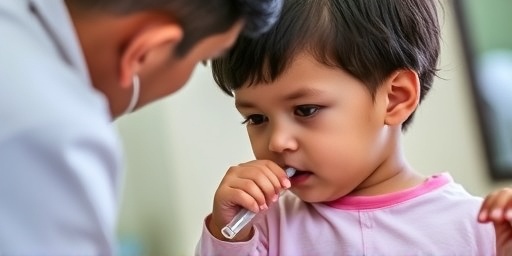Washington, D.C. – The Centers for Disease Control and Prevention (CDC) has sounded the alarm on a dramatic surge in Respiratory Syncytial Virus (RSV) cases among children across the United States, with hospitalizations among infants and toddlers spiking by up to 60% in several states. Health officials are urging parents to prioritize vaccination and implement strict precautions as the virus threatens to overwhelm pediatric wards this season.
- RSV Hospitalizations Double in Southern and Midwestern States
- CDC Pushes Expanded Vaccination Strategy to Curb Spread
- Seasonal Weather and Immunity Gaps Drive RSV Explosion
- Pediatricians Offer Real-Time Prevention Advice for Families
- Healthcare Systems Brace for Peak Season While Eyeing Long-Term Solutions
In a newly released alert, the CDC reported that over the past two weeks, RSV-related emergency department visits for children under 5 have jumped 45% nationally, with the hardest-hit regions including the Southeast, Midwest, and Pacific Northwest. Infants younger than 6 months are facing the steepest climb, with hospitalization rates doubling in states like Georgia, Tennessee, and Washington. “This is a significant and concerning uptick,” said CDC Director Dr. Rochelle Walensky in a statement. “RSV can be particularly dangerous for our youngest children, and we’re seeing early signs of what could be a severe season.”
RSV Hospitalizations Double in Southern and Midwestern States
The surge in RSV cases is hitting hardest where winter weather patterns are accelerating transmission. Data from the CDC’s Respiratory Virus Net (RV-Net) surveillance system shows that in Georgia, RSV positivity rates in pediatric tests reached 28% last week, up from just 12% a month ago. Tennessee reported a 75% increase in RSV hospitalizations for infants, while hospitals in Missouri and Illinois are diverting non-emergency cases to manage the influx.
Pediatricians on the front lines are documenting severe outcomes. At Children’s Healthcare of Atlanta, Dr. Andi Shane, an infectious disease specialist, noted, “We’ve seen a 50% rise in admissions for bronchiolitis caused by RSV. Many of these children require oxygen support or mechanical ventilation.” Nationally, the CDC estimates that RSV leads to 58,000-80,000 hospitalizations in children under 5 annually, but this year’s early surge could push those figures higher.
- Key Stats from CDC RV-Net:
- Infants <6 months: +60% hospitalization rate
- Toddlers 6-24 months: +35% ED visits
- RSV test positivity: 25% national average, peaking at 35% in South
These numbers echo patterns from the 2022-2023 season, when low immunity from COVID-19 disruptions fueled record cases, but experts warn this surge is arriving earlier than expected.
CDC Pushes Expanded Vaccination Strategy to Curb Spread
In response to the surge, the CDC is aggressively promoting vaccination for eligible groups. The agency recommends the new RSV monoclonal antibody, nirsevimab (Beyfortus), for infants entering their first RSV season, and maternal RSV vaccines like Abrysvo for pregnant women at 32-36 weeks to protect newborns. “Vaccination is our strongest tool,” emphasized Dr. Lindsey Baden, chair of the CDC’s Advisory Committee on Immunization Practices (ACIP). “We’ve seen up to 80% reduction in severe RSV disease with these interventions.”
Approval for these vaccines came in 2023, but uptake has been uneven. Only about 20% of eligible infants have received nirsevimab so far, per CDC tracking, hampered by supply shortages earlier this year. The agency is now coordinating with states to ramp up distribution, targeting high-risk areas first. Pediatric offices and pharmacies are being urged to prioritize appointments for children under 8 months.
| RSV Prevention Option | Target Group | Efficacy |
|---|---|---|
| Nirsevimab (Beyfortus) | Infants <8 months | 75-80% vs. hospitalization |
| Abrysvo (Maternal Vaccine) | Pregnant women 32-36 weeks | 82% vs. severe infant disease |
| Arexvy (Adult Vaccine) | Adults 60+, high-risk | Relevant for household protection |
States like California and New York have launched public awareness campaigns, with free vaccination clinics popping up in community centers.
Seasonal Weather and Immunity Gaps Drive RSV Explosion
Public health experts attribute the surge to a perfect storm of factors. Colder temperatures and indoor gatherings are supercharging RSV transmission, a virus that thrives in close-contact settings like daycares. “The drop in population immunity post-pandemic is key,” explained Dr. Helen Chu, a virologist at the University of Washington. “Fewer children were exposed during lockdowns, leaving a susceptible cohort now entering peak season.”
Additionally, waning maternal antibodies in breastfed infants and gaps in routine vaccination schedules exacerbate vulnerability. The CDC notes that RSV circulates year-round but peaks from November to March, with this year’s uptick starting unusually early in September. Climate anomalies, including a mild fall, may have delayed but intensified the wave.
- Primary Drivers: Seasonal humidity drops, school reopenings.
- Immunity Factors: COVID-era disruptions reduced natural exposures.
- Demographic Risks: Premature babies, those with heart/lung conditions face 5x higher hospitalization odds.
Comparative data shows this surge mirrors Australia’s severe 2023 season, which the US often previews due to hemispheric patterns.
Pediatricians Offer Real-Time Prevention Advice for Families
As RSV swamps clinics, doctors are dispensing targeted guidance. The American Academy of Pediatrics (AAP) aligns with CDC recommendations, advising handwashing, masking in crowds, and avoiding sick contacts. “Keep children home from daycare at the first sign of symptoms,” urges AAP President Dr. Moira Szilagyi. Common RSV signs include runny nose, cough, fever, and wheezing; seek care if breathing becomes labored.
High-risk families are prioritizing vaccination. In a survey by the CDC, 65% of parents expressed willingness to vaccinate once informed of the surge, but misinformation lingers. Social media campaigns are countering myths, emphasizing that RSV vaccines don’t cause the illness.
“RSV is the leading cause of infant hospitalization in the US – not COVID, not flu. Prevention through vaccination saves lives.” – Dr. Sean O’Leary, AAP Immunization Expert
Pharmacies like CVS and Walgreens report a 40% uptick in RSV-related consultations, stocking home test kits for early detection.
Healthcare Systems Brace for Peak Season While Eyeing Long-Term Solutions
With flu and COVID cases also rising, hospitals are activating surge protocols. The CDC forecasts RSV peaks through January, potentially straining ICUs. Federal funding via the Biden administration’s $1.2 billion pediatric preparedness initiative is bolstering stockpiles of antivirals like palivizumab for high-risk children.
Looking ahead, experts call for expanded vaccination programs, including universal infant dosing by 2025. Research into broader-spectrum vaccines is accelerating, with trials showing promise against multiple strains. Parents are advised to consult pediatricians now, as supplies may tighten. “This surge is a wake-up call,” said Dr. Walensky. “By vaccinating proactively, we can protect our children and ease the burden on our healthcare system.”
Stakeholders monitor wastewater surveillance for early warnings, aiming to flatten the curve before holidays amplify spread. As the nation navigates this RSV threat, collective action on vaccination and hygiene could avert a full-blown crisis.









